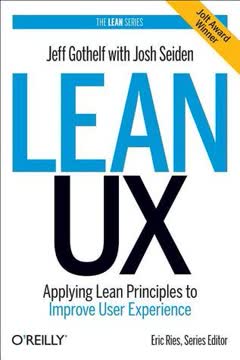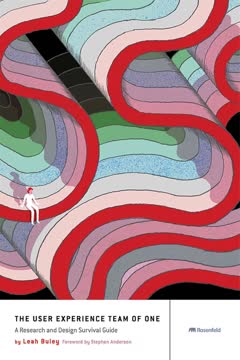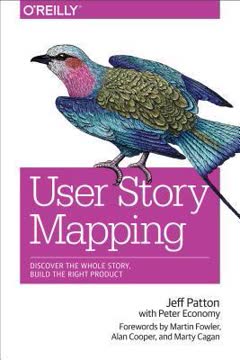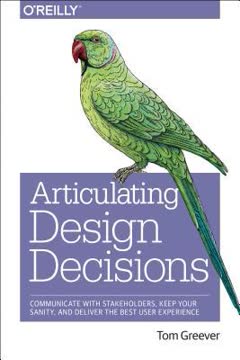Key Takeaways
1. UX Strategy: The Convergence of Business Strategy and UX Design
UX Strategy = Business Strategy + Value Innovation + Validated User Research + Killer UX Design
Defining UX Strategy. UX strategy is a holistic approach that combines business objectives with user-centered design principles. It goes beyond creating visually appealing interfaces to focus on delivering products that solve real user problems while achieving business goals. This approach requires a deep understanding of both the market landscape and user needs.
Key components. The four tenets of UX strategy are:
- Business Strategy: Understanding the competitive landscape and market opportunities
- Value Innovation: Creating unique value propositions that differentiate from competitors
- Validated User Research: Gathering empirical data to inform product decisions
- Killer UX Design: Crafting intuitive and engaging user experiences
By integrating these elements, UX strategists can create products that not only meet user needs but also drive business success.
2. Value Innovation: Creating Blue Oceans in the Digital Marketplace
Value innovation occurs when companies align newness with utility and price.
Blue Ocean Strategy. Value innovation is about creating uncontested market spaces, or "blue oceans," rather than competing in existing, saturated markets ("red oceans"). This approach focuses on simultaneously pursuing differentiation and low cost, creating a leap in value for both customers and the company.
Innovative digital products. Examples of successful value innovation in the digital realm include:
- Airbnb: Disrupting the hospitality industry by connecting homeowners with travelers
- Waze: Revolutionizing navigation through crowd-sourced traffic data
- Tinder: Simplifying online dating with a swipe-based interface
To achieve value innovation, UX strategists must:
- Identify unmet user needs
- Develop unique solutions that address these needs
- Create a business model that supports the innovative product
- Design a user experience that makes the product intuitive and engaging
3. Validated User Research: The Foundation of Successful Products
To make the competition irrelevant, you will have to offer something unique that radically improves on their current options.
Customer discovery. Validated user research is crucial for ensuring that a product solves real problems for its target audience. This process involves getting out of the building and engaging directly with potential customers to understand their needs, pain points, and behaviors.
Key steps in validated user research:
- Define your primary customer segment
- Identify the customer's biggest problem
- Create provisional personas based on assumptions
- Conduct customer discovery interviews
- Analyze findings and reassess your value proposition
By continuously validating assumptions through user research, UX strategists can minimize the risk of building products that don't resonate with their intended audience.
4. Competitive Analysis: Understanding the Market Landscape
You need to know exactly what they are doing. You want to know the unknowns.
Comprehensive market research. Competitive analysis is essential for understanding the existing landscape and identifying opportunities for differentiation. This process involves examining both direct and indirect competitors to gain insights into their strengths, weaknesses, and market positioning.
Steps in conducting competitive analysis:
- Identify competitors (both direct and indirect)
- Gather data on their products, features, and user experiences
- Analyze their business models and revenue streams
- Evaluate their marketing strategies and user acquisition methods
- Identify gaps and opportunities in the market
By thoroughly analyzing the competition, UX strategists can make informed decisions about product positioning, feature prioritization, and overall strategy.
5. Storyboarding and Prototyping: Visualizing the User Experience
The purpose of the key experience is to be more minimalistic. What feature set is the most integral part of the value proposition?
Visualizing concepts. Storyboarding and prototyping are powerful tools for communicating and testing product ideas before significant resources are invested in development. These techniques help teams align on the core user experience and identify potential issues early in the process.
Storyboarding process:
- Identify key experiences that define the product's value proposition
- Create a list of panels that illustrate the user journey
- Choose a visual format (digital montages or paper sketches)
- Layout the storyboard and add captions to explain each step
Prototyping techniques:
- Paper prototypes for quick concept testing
- Digital wireframes for more detailed interaction design
- Interactive prototypes for user testing and stakeholder presentations
By using these visualization techniques, UX strategists can effectively communicate their vision and gather valuable feedback before committing to full-scale development.
6. Guerrilla User Research: Swift and Efficient Customer Validation
You want to actively listen to people and engage them because your goal is to uncover the specific problem that they need solved.
Rapid validation. Guerrilla user research is a cost-effective and time-efficient approach to gathering user feedback. This method involves conducting quick, informal interviews or tests with potential users in real-world settings, such as cafes or public spaces.
Key steps in guerrilla user research:
- Define research objectives and prepare questions
- Scout locations and plan logistics
- Recruit participants on-site
- Conduct brief interviews or usability tests
- Analyze findings and iterate on the product concept
Benefits of guerrilla research:
- Low cost and quick turnaround
- Access to a diverse range of participants
- Immediate feedback on product concepts
- Ability to iterate rapidly based on findings
By incorporating guerrilla research techniques, UX strategists can continuously validate their assumptions and refine their product concepts throughout the development process.
7. Designing for Conversion: Optimizing the User Journey
If you want to be a closer, you must constantly tweak your UX strategy to increase successful outcomes for user engagement and customer acquisition.
Conversion-focused design. Designing for conversion involves creating user experiences that guide users towards desired actions, such as signing up, making a purchase, or engaging with key features. This approach requires a deep understanding of user behavior and motivations, as well as continuous optimization based on data and user feedback.
Key elements of conversion-focused design:
- Clear and compelling value propositions
- Intuitive navigation and information architecture
- Effective calls-to-action (CTAs)
- Streamlined forms and checkout processes
- Trust-building elements (e.g., social proof, security indicators)
- Personalized experiences based on user behavior and preferences
By prioritizing conversion in the design process, UX strategists can create products that not only satisfy user needs but also drive business results.
8. The Funnel Matrix: Aligning Business Goals with User Needs
The purpose of filling out the Funnel Matrix is to force the entire team involved with the product to think through all the required actions potential users and customers must make as they progress down the funnel to become repeat users.
Holistic funnel analysis. The Funnel Matrix is a powerful tool for aligning business objectives with user needs throughout the customer journey. This framework helps teams identify key metrics, desired actions, and required functionality at each stage of user engagement.
Components of the Funnel Matrix:
- User's Process: The types of activities users engage in at each stage
- Desired Action: What you want users to do in response to their experience
- Business Task: What must happen behind the scenes to enable the user's process
- Metrics: Units of measurement for user performance and engagement
- Required Functionality: Features and platforms necessary for each funnel stage
- Validated Learnings: Insights gained from analyzing user behavior and metrics
By using the Funnel Matrix, UX strategists can create a shared understanding of the product's goals and user journey across all team members and stakeholders.
9. Growth Hacking: Accelerating User Acquisition and Engagement
Growth hacking is a term coined in 2010 by Sean Ellis, a marketing blogger and entrepreneur. The concept behind it is for product teams to come up with extremely clever, cost-efficient ways to increase customer growth.
Data-driven growth. Growth hacking combines marketing, product development, and data analysis to rapidly experiment with various strategies for user acquisition and engagement. This approach is particularly useful for startups and new products looking to gain traction in competitive markets.
Key growth hacking techniques:
- A/B testing of landing pages and user flows
- Viral loops and referral programs
- Content marketing and SEO optimization
- Social media marketing and influencer partnerships
- Email marketing and retention campaigns
- Product-led growth strategies
Metrics to track:
- User acquisition cost (CAC)
- Conversion rates at each funnel stage
- User retention and churn rates
- Lifetime value (LTV) of customers
- Viral coefficient and growth rate
By incorporating growth hacking techniques into their UX strategy, product teams can accelerate user adoption and create sustainable growth engines for their products.
Last updated:
FAQ
What's UX Strategy: How to Devise Innovative Digital Products That People Want about?
- Focus on UX and Business: The book emphasizes the integration of user experience (UX) design with business strategy to create innovative digital products.
- Framework and Techniques: It provides a practical framework and lightweight techniques applicable in various work environments, making UX strategy accessible to both designers and non-designers.
- Real-World Insights: Jaime Levy shares insights from her extensive experience, including case studies and interviews with top strategists, to illustrate the principles discussed.
Why should I read UX Strategy by Jaime Levy?
- Bridging Knowledge Gaps: The book addresses the gap between UX design and business strategy, making it valuable for entrepreneurs and product managers.
- Empirical Approach: It encourages an empirical approach to product development, emphasizing validated user research and testing.
- Comprehensive Toolkit: Readers gain access to a UX Strategy Toolkit, which includes templates and tools to implement the strategies discussed.
What are the key takeaways of UX Strategy?
- Four Tenets of UX Strategy: The book outlines four essential components: Business Strategy, Value Innovation, Validated User Research, and Killer UX Design.
- Importance of User Research: It stresses the need for validated user research to ensure products meet real customer needs and avoid costly assumptions.
- Iterative Process: The book promotes an iterative process of testing and refining ideas, crucial for successful product development.
What is the UX strategy framework presented in UX Strategy?
- Four Tenets Explained: The framework consists of Business Strategy, Value Innovation, Validated User Research, and Killer UX Design, working together to create a successful product.
- Interconnectedness: Each tenet influences the others, and understanding their relationships is key to developing a cohesive UX strategy.
- Practical Application: The framework is designed to be practical and applicable, allowing teams to implement it regardless of their work environment.
How does UX Strategy define value innovation?
- Creating Unique Value: Value innovation is described as the simultaneous pursuit of differentiation and low cost, creating a leap in value for both customers and the company.
- Disruptive Innovation: The book references Clayton Christensen's concept of disruptive innovation, highlighting how new products can redefine market expectations.
- Examples Provided: It illustrates value innovation through case studies of successful companies that have transformed their industries by offering unique solutions.
What is the significance of validated user research in UX Strategy?
- Empirical Validation: Validated user research is crucial for confirming that a product's value proposition resonates with the target audience.
- Avoiding Assumptions: The book emphasizes that relying on assumptions can lead to product failure, making user research a non-negotiable step in the development process.
- Methods of Research: It discusses various methods for conducting user research, including guerrilla testing and customer interviews, to gather actionable insights.
What are some practical techniques for implementing UX strategy from UX Strategy?
- Competitive Analysis Matrix: The book introduces a matrix tool for conducting competitive analysis, helping teams identify strengths and weaknesses in the market.
- Storyboarding: It encourages the use of storyboards to visualize key experiences and value propositions, making it easier to communicate ideas.
- Prototyping: The book discusses the importance of creating prototypes to test hypotheses and gather user feedback before full-scale development.
How does Jaime Levy suggest handling competition in UX Strategy?
- Thorough Research: The book advocates for comprehensive competitive research to understand the landscape and identify opportunities for differentiation.
- Analyzing Competitors: It encourages teams to analyze both direct and indirect competitors to learn from their successes and failures.
- Adapting Strategies: The author suggests adapting strategies based on competitive insights to ensure that the product stands out in the market.
How can I apply the Funnel Matrix tool from UX Strategy?
- Understanding User Engagement: The Funnel Matrix helps teams visualize the stages of user engagement, from suspect to reference user.
- Collaborative Tool: This tool is designed for collaboration among cross-functional teams, including designers, developers, and marketers.
- Data-Driven Decisions: By filling out the Funnel Matrix, teams can make data-driven decisions based on user behavior and feedback.
What are some common misinterpretations about UX strategy according to Jaime Levy?
- Beyond a "North Star": One common misinterpretation is that UX strategy is merely about identifying a "North Star," but it encompasses a broader understanding of user needs and business goals.
- More than UX Design: Another misconception is that UX strategy is just a strategic way to perform UX design; it involves integrating user experience into the overall business strategy.
- Not Solely Product Strategy: Some believe that UX strategy is solely product strategy, but it also includes understanding user behavior, market trends, and the competitive landscape.
What are the best quotes from UX Strategy and what do they mean?
- "It’s all about the experience.": This quote encapsulates the core philosophy of the book, emphasizing that user experience should be the primary focus in product development.
- "Strategy is about connecting the dots.": This highlights the importance of understanding the relationships between past, present, and future in crafting effective strategies.
- "A solid strategy is the difference between success and failure.": This underscores the critical role that a well-defined strategy plays in achieving product success in a competitive market.
How does Jaime Levy define a value proposition in UX Strategy?
- Definition of Value Proposition: A value proposition is defined as the unique value that a product offers to its users, addressing their specific needs and pain points.
- Importance of Validation: Levy emphasizes the need to validate the value proposition through user research and testing.
- Iterative Refinement: The book advocates for continuously refining the value proposition based on user feedback and market changes.
Review Summary
UX Strategy receives mixed reviews, with an average rating of 3.98 out of 5. Many readers praise its practical approach, real-life examples, and valuable insights into UX strategy and product development. Some found it particularly useful for startups and small companies. Critics argue that the book lacks a clear target audience, contains unnecessary details, and may not offer much new information for experienced professionals. Despite these criticisms, many readers appreciate the author's experience and the book's focus on aligning UX with business strategy.
Similar Books










Download PDF
Download EPUB
.epub digital book format is ideal for reading ebooks on phones, tablets, and e-readers.




